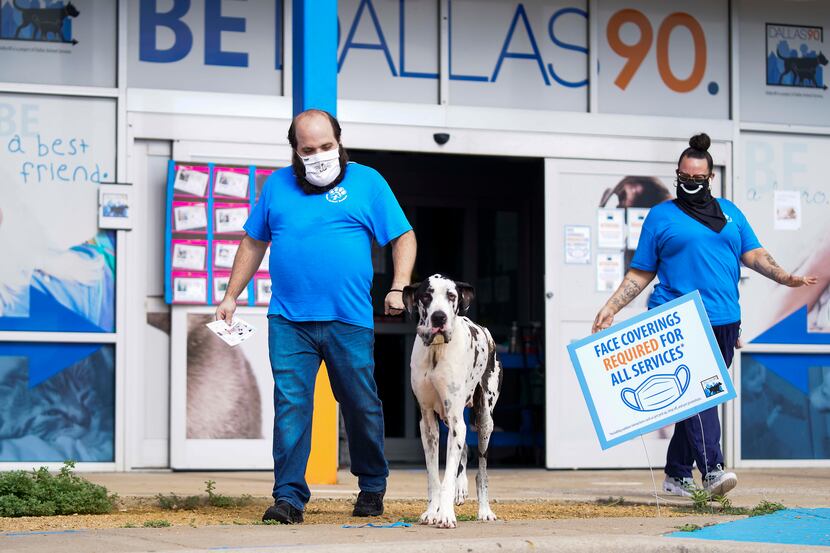Spend any time in the world of animal advocacy and you’ll encounter issues and incidents in which dog and cat lovers’ emotions outrun the facts.
Back in 2015, I too fell into that passion trap.
Frustrated by Dallas Animal Services’ flagrant disregard for the loose-dog crisis it had allowed to wreak havoc on so many southern Dallas neighborhoods, I responded with a harsh column about whether the city was genuinely considering the welfare of cats and dogs that it was giving away in the annual “Clear the Shelters” event.
Five Augusts later, as the fees-waived adoption event has again kicked off across North Texas, I want to be on the record with a different point of view. My turnaround is the result of looking more deeply into the research, getting comfortable with a vastly improved Dallas Animal Services — and realizing that my 2015 column was interpreted by some as proof that poor people don’t deserve pets.
Before I tell you why I changed my mind, it’s important to recall the dire situation that so many dogs faced in Dallas when I wrote about the nationwide — and hugely popular — Clear the Shelters campaign:
Southern Dallas residents pleaded regularly for something to be done about the loose and stray animals wandering their neighborhoods. They came to City Hall with stories of warding off menacing dogs at their bus stop, of being too scared to walk around the block or let their children play outside, of ER visits after they jumped between their own pet and a vicious stray.
Despite the residents’ anecdotes, the City Council’s demands that Dallas Animal Services do its job and this newspaper’s barrage of editorials, the shelter’s only response under its previous leadership toggled between excuses and a “move on down the road, nothing to see here” attitude.

As a member of this newspaper’s Editorial Board at the time and leader of our decadelong “Bridging Dallas’ North-South Gap” campaign, I wrote dozens of opinion pieces pointing out the unconscionable loose-dog chaos — just one of the many examples of pernicious problems that would not be tolerated in the northern half of our city.
I spent a lot of time driving southern Dallas streets to see for myself the swarms of neglected dogs that residents had told me about in community meetings. In neighborhood after neighborhood, I talked with citizens who would venture out on a daily walk only if armed with golf clubs and tree limbs.
So no, in 2015, the idea of “clearing the shelters” and potentially sending more dogs into potentially tragic circumstances sounded like a terrible idea. I responded with a column that questioned whether the new owners were getting a full picture of the responsibilities and costs involved in adopting — or whether we were setting up beleaguered residents for even more loose and neglected animals.
But a lot has changed in five years: I’ve gotten smarter about data on shelter promotions and, more important, our city — especially southern Dallas and its animals — got the leader we deserve when Ed Jamison was hired as director of Dallas Animal Services in 2017.
Jamison wasn’t always a fan of adoption campaigns that waive fees for new owners. He, too, questioned whether giveaways increased the risk of animals receiving poor care or being abandoned. But over time, he determined that research has turned up no correlation between the payment of a fee and adoption success.
“People just like a promotion and, like Black Friday for Christmas shopping, many families tell the kids that Clear the Shelters time is when they’ll get a puppy,” Jamison told me recently. His shelter is again one of the more than 60 North Texas locations in the effort, sponsored by KXAS-TV (NBC5) and KXTX-TV (Telemundo 39).

Because COVID-19 has forced most shelters to conduct online or by-appointment meetings between potential owners and pets, local fee-waived adoptions will run from Aug. 24 to 29 rather than be offered only a single day.
Nada Ruddock, NBC5′s vice president of community affairs, deserves credit for starting the initiative in 2014, with a big assist from Corey Price, Irving Animal Services manager. “Corey was so worried that shelters were having to euthanize adoptable animals to make room for incoming animals,” Ruddock recalled.
That first year, 33 shelters matched about 200 animals with owners on the day they waived fees. Last year, 7,719 animals were adopted in the D-FW area.
Some people begin looking into adoption when the first local TV promotions roll out at the beginning of August. For instance, of the animals adopted last year, 5,084 of the matches came before the official Clear the Shelters day, when 2,600 were adopted.
When Dallas Animal Services holds reduced- or fee-waived events, Jamison said, he hears regularly from critics who assume the adopters “are poor and therefore incapable of being a good pet owner.”
My latest interview with Jamison about Clear the Shelters comes at a time when his is a big voice in equity discussions taking place nationwide regarding animal adoption policies and whether they reflect biases against underserved and marginalized communities.

The message from Jamison, one of the few Black leaders in his field: “If your adoption practices put up barriers to anyone, you’re a part of the problem.” The goal at Dallas Animal Services is to create a welcoming environment for everyone and have informative conversations with would-be adopters, he said.
Jamison told me he has never found evidence in Dallas that people use Clear the Shelters to adopt animals for nefarious purposes. With safeguards such as microchipping in place, he said, “why would someone who wants to adopt an animal, say for fighting, want their actions to be documented by virtual or paper trails?”
My look into data shows that as more shelters and rescues have removed barriers to adoptions, return rates have remained consistent over the past decade. Other studies indicate that people who adopted pets without paying anything had the same degree of attachment as those whose new dog or cat had a fee attached.
Locally, Jamison says, return rates of pets and what his field officers see on the streets affirm the research. “Your net worth is not a barometer for your ability to love and care for a pet,” he told me.
I came away from the conversations and research troubled that, in my 2015 zeal to help solve southern Dallas’ loose-dog chaos, I fed the flames of a stereotype that poor people can’t care for pets and provided a written tool for others who wanted to believe that stereotype.
That made me all the more committed to write this “do-over.”
Since the pandemic forced Dallas Animal Services into online adoptions, the fees it ordinarily charges have been on ice. But Clear the Shelters is still important, Jamison said, because it brings awareness to the Dallas operation.
“Many people who never go to our Facebook page or read your newspaper article may hear about us through the promotion,” he said.
Jamison understands the point of my 2015 column; he has heard plenty of stories about the old Dallas Animal Services. These days — with the loose-dog problem under control — rather than stigmatize pet owners who need help, the shelter wants to be a resource for services and information.
“Many of these people will make sure their pet eats before they eat,” Jamison said. “Our job is to help everyone be the best possible owner, not set up barriers based on race or income.”
You can learn more about this month’s Clear the Shelters initiative and see the full list of participating locations at nbcdfw.com.

